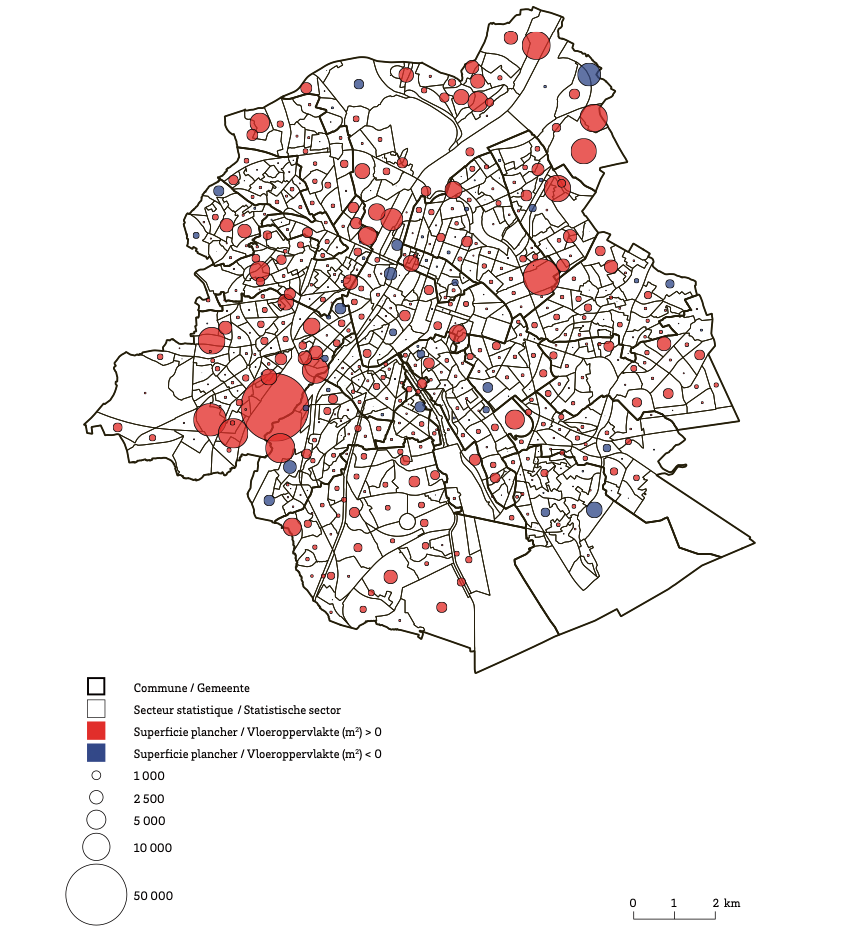All of the Brussels-Capital Region is expanding in terms of construction – but some neighbourhoods are doing so much faster than others. New data on building permits has highlighted which parts of the region have most rapidly grown.
Planning body Perspective Brussels has published a new report painting a picture of urban development in the region, from housing to offices and trade, based on urban planning permits to understand how space is being used.
"During the 2020-2021 period, planning permission was granted for an average of about 406,000 m2 of floor space per year, corresponding to an annual average density of 25 m2/ha," experts wrote in the report. "This is 40,000 m2 more than during the 2018-2019 period, a direct consequence of the large number of permits granted in 2021." This points to a catch-up effort following the pandemic in 2020.
Most of the additional floor space is for residential use, with licensing authorities issuing permits for an average of 920,000 m2 of housing over the two years combined. The region also lost a lot of floor space, the bulk of which was office space (-145,000 m2 per year). "These two dynamics are often linked, mainly because many office buildings are being converted into housing. This trend seems to be increasing in recent years," likely because of a rise in remote working, again driven by the pandemic.
Fastest-growing districts
One of the main zones where additional floor space was licensed in the 2020-2021 period was Reyers, located in Schaerbeek. This is largely due to the development of the Mediapark around RTBF and VRT, where a residential area (with some 1,400 homes) and green spaces are being added.

Illustration shows the total Net Floor Area (average 2020-2021). The red circles indicate increased building, blue indicates buildings that disappeared. Credit: perspective.brussels
Besides Reyers, the southern canal zone – mainly around the Biestebroek dock in Anderlecht – is also rapidly expanding. Here, an abandoned industrial site was transformed into an enterprise zone, with thousands of new homes being built (the Key West project). On the map, this is illustrated by the largest red circle.
The northern boroughs of Haren and Neder-Over-Heembeek (both in the City of Brussels commune) were also cited as being the most dynamic, with the development of a large number of housing units. The arrival of Tram 10, connecting Neder-Over-Heembeek with Brussels city centre, will likely drive further expansion.
While the very prominent addition of housing is necessary in the short term as Brussels faces a housing crisis, city associations have warned that these plans do not sufficiently take into account the projected decline of the region's population. Some also argue too many expensive properties are coming on the market, while the need for affordable housing persists.
Highest density zones
Perspective Brussels also for the first time calculated all existing floor areas in the region to analyse expected densification in the future, which is expressed in m2/ha.
"The zones with the highest density are in the city centre, the North Quarter and the European Quarter," experts said. "That density follows a concentric pattern (from the centre to the periphery) that follows the historical growth of the city."
The Rogier district in Saint-Josse-ten-Noode (where the density at 2,000 m2/ha is exceedingly high due to one or two large-scale projects) and the zone around Rue de Pascale near the European Parliament are areas where the density is already high and will only increase.
Meanwhile, there are also zones where the building density is currently low (less than 10,000 m2/ha) and where it will most likely go up (by more than 400 m2/ha), including several areas in Anderlecht (Petite-Île - Rive droite, Deux gares and Ceria), Germinal II in Evere and Condor in Molenbeek-Saint-Jean.

